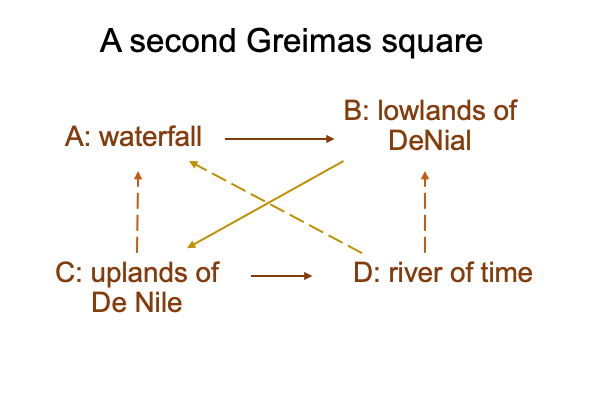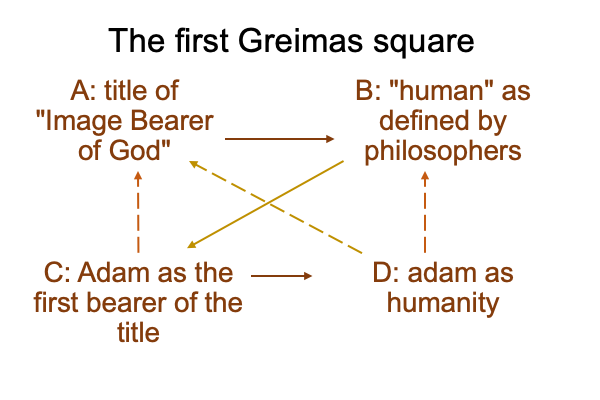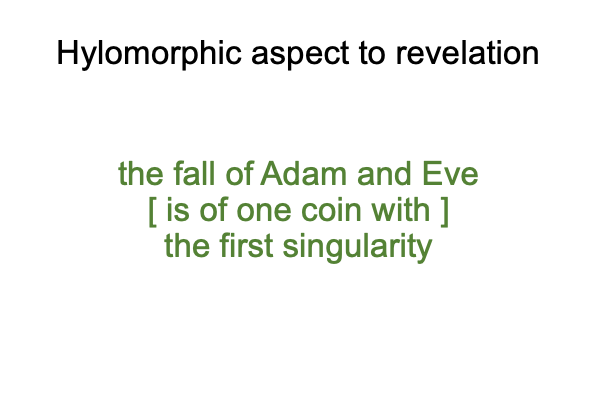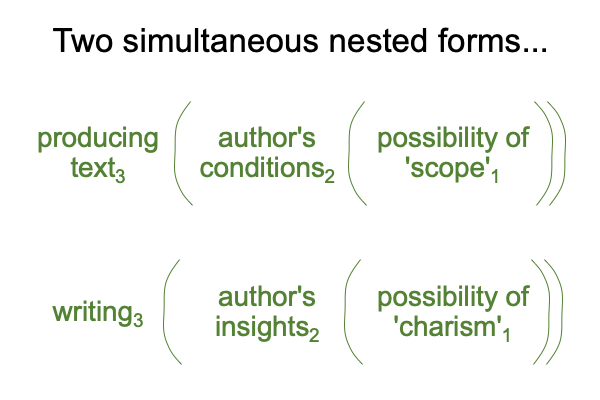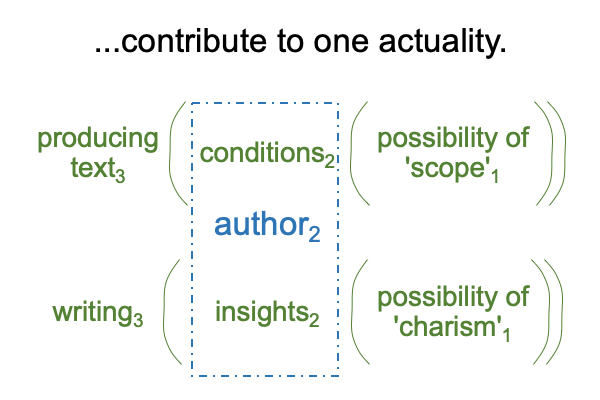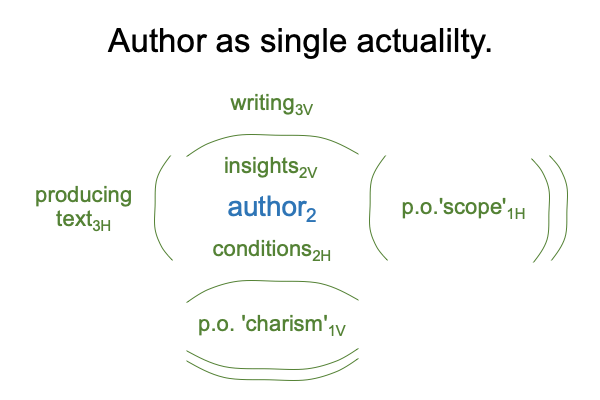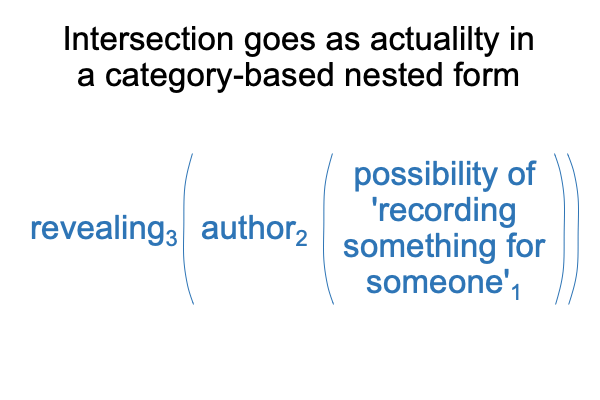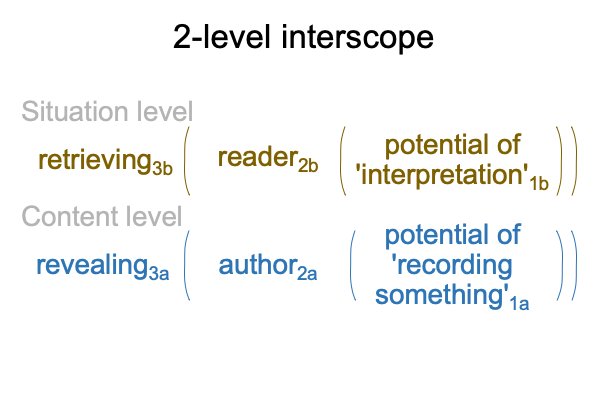Looking at Andrew Ter Ern Loke’s Book (2022) ” The Origin of Humanity and Evolution” (Part 1 of 22)
0001 The book under examination is published by T&T Clark in New York, London and Dublin, carries an ISBN number: 978-0-5677-0635-5, and presents the full title of The Origin of Humanity and Evolution: Science and Scripture in Conversation.
This examination considers the book from the point of view of Razie Mah’s three masterworks, The Human Niche, An Archaeology of the Fall and How To Define The Word “Religion”, corresponding to the Lebenswelt that we evolved in, the first singularity and our current Lebenswelt, respectively.
Needless to say, in this volume, Andrew Ter Ern Loke is not aware of the scientific proposals offered by Razie Mah’s masterworks. His goal is to formulate a point of view whereby the role of Adam and Eve in Augustine’s Christian tradition does not contradict the modern view of human evolution, which is surpassed by Razie Mah’s corrective.
The goal of this examination is to show that Loke intimates the proposed scientific corrective, even though he is unaware of its existence.
0002 According to the back cover, in 2022, Andrew Ter Ern Loke is an associate professor at Hong Kong Baptist University. In the acknowledgements, the author thanks scientists, philosophers, a historian of science, biblical scholars and theologians for helpful discussions. Among the list is William Lane Craig, whose recent book, The Historical Adam, is reviewed in November 2022 in Razie Mah’s blog.
Loke’s book is dedicated to a computational biologist, Joshua Swamidass, who proposes a technical solution that permits all humans to descend from one male, named “Adam”, and that one “Adam” corresponds to the one mentioned in Genesis 2.4 on.
0003 Technical solution?
There are two stories of human origins in the formerly Christian West, the Christian ones are found in Genesis and the modern Western ones concern the scientific disciplines of natural history, genetics and archaeology. So the question arises, asking, “How do these match?”
They would match if “Adam” is the first human. After all, the name, “adamah”, is ambiguous, referring to humankind, the male of the species, as well as one apparently ill-fated fellow once living on an island, in a special place called, “Eden”, near the confluence of four rivers, including the Tigris and Euphrates.
0004 Unfortunately, the scientific discipline of genetics rules out that option. Adam and Eve are not the first pair of humans. Contemporary human population genetics shows no sharp bottleneck that would correspond to a single pair as the first humans (as proposed by Saint Augustine, over 1600 years ago, during the twilight of the Roman Empire). This lack of correspondence opens the opportunity for other technical solutions, such as the genealogical approach by Joshua Swamidass and the approach formulated in Loke’s book. Neither Swamidass nor Loke propose that Adam and Eve are the first humans. Loke designates Adam as “God’s Image Bearer” and works from there.
0005 Here is a different way to look at the issue.
Imagine a map of the Nile, running up through Africa to the Mediterranean Sea. Now, pick up a mental pencil and relabel parts of the great river.
0006 The first chapter of Genesis is the upper reaches of the southern Nile, with the great lake, named “Victoria” (to those who speak English). Genesis 2.4-10 is like the lower reaches of the northern Nile, ending in the magnificent delta. The Mediterranean is where history begins.
Imagine that there is a great waterfall between the upper and lower reaches, instead of a series of impassable rapids. Upland from the waterfall is the time of De Nile. Downland from the waterfall is the time of DeNial. The waterfall is the first singularity.
A traveler, starting at the falls, can theoretically walk in both directions, along De Nile or along DeNial. But, there is the challenge of the descent and the ascent. Looking from the top of the falls, one cannot see the bottom. Looking from the bottom of the falls, one cannot see the top. However, at either location, the traveler knows that there must be a bottom and there must be a top.
Well, the traveler does not really know for certain.
The traveler only looks down from the top or up from the bottom and makes a guess about the other realm.
0006 As if to repeat the pattern, Loke’s book takes a turn near the middle of the text, in section five of chapter five, carrying the title, “The Image of God”.
Loke writes that Adam and Eve, labeled by God as “Image Bearers of God”, are the first human beings. This does not require them to be the first anatomically modern humans or the genetic founders of all humans. Rather, the key issue is how humans are defined.
0007 It is sort of like that imaginary waterfall.
If one stands upstream, which is highland and south, human beings are defined by the scientific scenario summarized in section 5.1.
If one stands downstream, which is lowland and north, various philosophers and religious traditions offer opinions as to what humans are. Loke mentions Plato, Aristotle, Upanishadic Hinduism, Buddhism, Marxism, existentialism, sociobiology and contemporary philosophy. Each has a unique definition of “the human”.
The waterfall is neither upstream nor downstream. The waterfall is contiguous with both.
How does this division within continuity work?
0008 The Greimas square may assist. The Greimas square is a purely relational structure that is useful for discerning a constellation of meanings that surround a particular spoken term.
A century ago, the linguist Ferdinand de Saussure proposed that spoken language consists in two arbitrarily related systems of differences, parole (French for “talk”) and langue (French for “language”). One system is external. Parolecan be scientifically observed and measured. Langue is internal, only certain changes in physiological conditions can be observed and measured.
0009 So, the question arises, “How does one define any particular spoken phrase or word?”
That is the subject of Razie Mah’s masterwork, How To Define the Word “Religion”, available at smashwords and other e-book venues.
0010 Happily, for this examination, there is method that respects the purely relational configuration posed by Saussure.
That method is the Greimas square.
0011 Here is a picture.
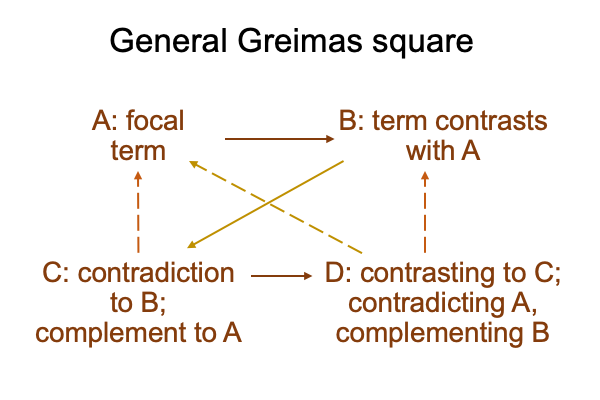
0012 The focal term goes with A.
The first contrast of A that comes to mind enters B.
Then, a term that contradicts B goes into C. The term, “contradicts”, may be transliterated into “speaks against”. So, C speaks against B. Then, one finds that C complements A.
Finally, a contrast that comes to mind with C goes into D. Then, one should find that D speaks against A and complements B.
0013 The Greimas square is a probe of the terms that are adjacent to (or metaphorically “near”) a focal term (A).
0014 The following figure applies to Loke’s discussion of Adam and Eve as the first “Image Bearers of God”.
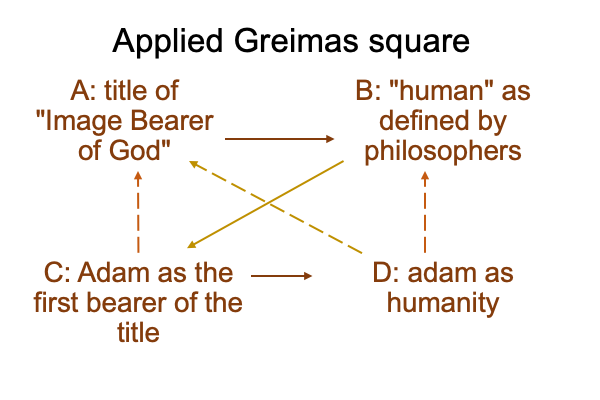
0015 We are the descendants of Adam (A), so we are heir to his title, “Image Bearer of God”.
But, there is a problem. Adam falls. So do we.
In contrast, many philosophies and traditions define who we are (B) without regard to God’s original appellation.
Speaking against the philosophers and traditionalists, Adam is the first holding the title (C), which will be passed on to the rest of humanity by means that are not genetic. So, despite all other opinion, Adam is… er, at least… was… until, you know, the unfortunate incident… the first bearer of this title. I suppose he never lost the title…
…he just made a bad decision that doomed all of subsequent humanity.
In contrast, the Biblical use of adam (technically, “adamah”) is a pun which means “earth man” or “humanity” (D).
This raises the question as to whether adam as humanity (D) contradicts (A) humans labeled as the Image Bearers of Godand complements (B) “humans” defined by philosophers and other religious traditions.
I suppose that one could argue for “yes”, as well as “no”.
0016 As it turns out, the metaphor of a map of the Nile River, altered by a number 2 pencil, also fits into a Greimas square.
